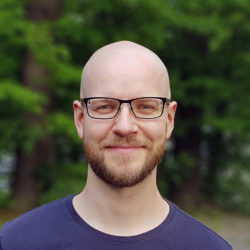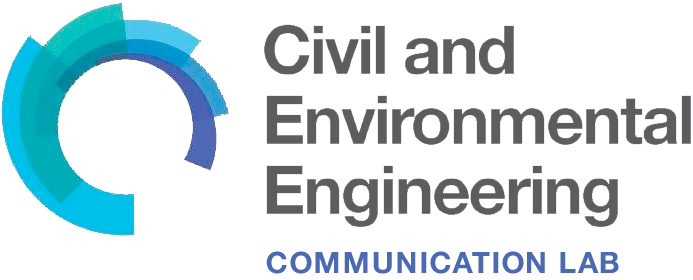 Matti Gralka is a postdoctoral fellow in the Cordero Lab in CEE and has been with the CEE Communication Lab (CEECL) since its inception in March 2020, leading workshops, panels, and coaching many students and postdocs on various topics surrounding science communication.
Matti Gralka is a postdoctoral fellow in the Cordero Lab in CEE and has been with the CEE Communication Lab (CEECL) since its inception in March 2020, leading workshops, panels, and coaching many students and postdocs on various topics surrounding science communication.
In this interview, Matti shares insights from his experiences as a CEE Comm Lab Fellow. He talks about what drew him to the Comm Lab opportunity, how he’s grown from the experience, and how much value he believes the CEE Comm Lab brings to the students and postdocs who use its coaching services.
What intrigues or inspires you as an MIT CEE postdoc?
I came to microbiology from a physics background, knowing very little about environmental bacteria. It’s been a fantastic time learning a lot about the various kinds of bacteria that populate our bodies and environments. I really enjoy trying to figure out what they might be doing in their natural habitats, and understanding the many solutions that nature has come up with for the fundamental problem of all living things: survival. What I love about MIT is that I can follow my intuitions and ideas as a physicist while being able to collaborate with world-class experts in all aspects of biology. For example, in a project I am working on right now, I am trying to discover patterns in what diverse bacteria from the ocean like to eat by analyzing hundreds of different types of bacteria. This is a bit of a physicist’s approach: measure things carefully first and then worry about what it means later. But through collaborations and discussions with biologists from MIT and elsewhere, we are now relating those patterns I found to very fundamental biological processes and characteristics, which may allow us to predict what bacteria in the wild might be doing without having to actually study them in the lab.
Tell us a little about your work in the CEE Communication Lab (CEECL). What have you been doing lately as a Fellow and peer-to-peer communication coach?
I am slowly transitioning to the next stage in my career [as a professor], and I was interviewed by Bensu Manav and Ignacio Arzuaga Garcia, two other current CEECL Fellows. We talked about the vagaries of applying for faculty positions, developing your identity as a scientist, and the differences between academic systems and cultures in Europe and the US. Together with Sid Pai, a CEECL Fellow and grad student, I’ve also been preparing a CommKit on poster presentations, which guides engineers on how to make their first (or tenth!) scientific poster.
As far as coaching goes, I’ve been helping students on a variety of topics, from qualifying exams to fellowship and faculty applications. The communication needs of our students and postdocs are really diverse, so it’s always new and exciting. As Comm Lab Fellows, we approach coaching as a collaborative effort. So, rather than us teaching or editing for the clients, we discuss ways that the clients themselves can discover and make the changes they feel will improve their document or presentation. I really like that approach because it has taught me a lot about mentoring in general.
Why did you decide to apply to become a CEECL Fellow? How has the experience been for you so far?
My experience has been wonderful. As Fellows, in our preparation to be peer-to-peer coaches, we receive solid training on many aspects of communication, which has definitely helped me become a better communicator but also a better mentor. I started in the first cohort of CEECL Fellows, so I didn’t have much information about what the Comm Lab was going to be exactly. But the idea of improving my own communication and mentoring skills while helping others with their own science communication sounded both useful and very exciting.
Simply conceptualizing and discussing different aspects of communication has been immensely helpful in thinking more clearly about how to structure presentations or write text. For instance, for writing papers, abstracts, or even elevator pitches, we often rely on the hourglass model, in which we start our text with a broad focus to grab the audience and frame our research in a large context, then narrow it down to what we actually did, and then open the focus up again to highlight what our research might lead to in the future. Conceptualizing their writing using such models can help our clients self-edit and write more confidently in the future. It also prompts us to think about our audience, which is critical in designing our communication—what knowledge can be presumed, what needs to be explained, what will the audience find implicitly convincing, and when do we need to work hard to make a strong case for the importance of our work.
I’ve also learned some techniques for effective mentoring that have really helped me help our clients. As a coach, I ask a lot of questions and have the clients figure out the best way forward in many cases. As a grad student, it may feel odd to provide feedback on a faculty application written by a senior postdoc. But even having never prepared a faculty application, we can still point out unclear passages, overuse of jargon, or leaps in logic.
What do you most enjoy about being a peer-to-peer communication mentor and Comm Lab Fellow, and why?
Peer-to-peer coaching is probably my favorite part of the job because it’s always great to see when the client is (hopefully) much happier with the product after the session than they were at the start. As Fellows, we try to not just improve a single product, though, but instead show the clients how to think deeply about their communication choices. When repeat clients notice clear improvements in their communication skills, that is always very rewarding.
You can connect with Matti on Twitter and through his website. You can also make a coaching appointment with Matti or any of the CEE Comm Lab Fellows using our online scheduler. Learn more about the CEE Comm Lab on our website.
